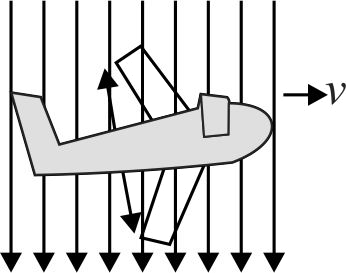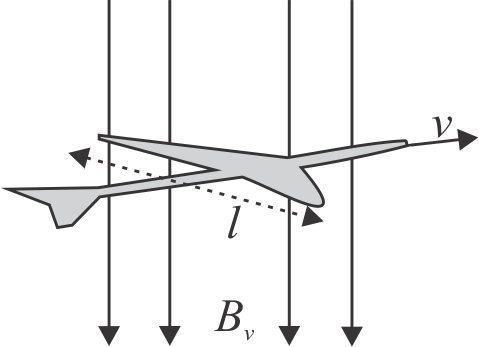358466 An aircraft with a wingspan of \(40\;\,m\) flies with a speed of \(1080\;\,km/hr\) in the eastward direction at a constant altitude in the northern hemisphere, where the vertical component of the earth's magnetic field \(1.75 \times {10^{ - 5}}\;\,T\). Then the emf developed between the tips of the wings is
358467 A jet plane is travelling towards west at a speed of \(1800\,\;km/h\). What is the voltage difference developed between the ends of the wing having a span of \(25\;\,m\), if the earth's magnetic field at the location has a magnitude of \(5 \times {10^{ - 4}}\;\,T\) and the dip angle is \(30^{\circ}\)
358468
The figure shows four wire loops, with edge lengths of either \(L\) or \(2L\). All of four loops will move through a region of uniform magnetic field \(\vec{B}\) (directed out of page) at the same constant velocity. Rank the four loops according to the maximum magnitude of the e.m.f. induced as they move through the field, greatest first
358469 An aircraft with a wing span of \(40\,m\) flies with a speed of \(1080\,km{h^{ - 1}}\) in the eastward direction at a constant altitude in the northern hemisphere, where the vertical component of earth's magnetic field is \(1.75 \times {10^{ - 5}}\,T.\) The \(emf\) that develops between the tips of the wing is
358466 An aircraft with a wingspan of \(40\;\,m\) flies with a speed of \(1080\;\,km/hr\) in the eastward direction at a constant altitude in the northern hemisphere, where the vertical component of the earth's magnetic field \(1.75 \times {10^{ - 5}}\;\,T\). Then the emf developed between the tips of the wings is
358467 A jet plane is travelling towards west at a speed of \(1800\,\;km/h\). What is the voltage difference developed between the ends of the wing having a span of \(25\;\,m\), if the earth's magnetic field at the location has a magnitude of \(5 \times {10^{ - 4}}\;\,T\) and the dip angle is \(30^{\circ}\)
358468
The figure shows four wire loops, with edge lengths of either \(L\) or \(2L\). All of four loops will move through a region of uniform magnetic field \(\vec{B}\) (directed out of page) at the same constant velocity. Rank the four loops according to the maximum magnitude of the e.m.f. induced as they move through the field, greatest first
358469 An aircraft with a wing span of \(40\,m\) flies with a speed of \(1080\,km{h^{ - 1}}\) in the eastward direction at a constant altitude in the northern hemisphere, where the vertical component of earth's magnetic field is \(1.75 \times {10^{ - 5}}\,T.\) The \(emf\) that develops between the tips of the wing is
358466 An aircraft with a wingspan of \(40\;\,m\) flies with a speed of \(1080\;\,km/hr\) in the eastward direction at a constant altitude in the northern hemisphere, where the vertical component of the earth's magnetic field \(1.75 \times {10^{ - 5}}\;\,T\). Then the emf developed between the tips of the wings is
358467 A jet plane is travelling towards west at a speed of \(1800\,\;km/h\). What is the voltage difference developed between the ends of the wing having a span of \(25\;\,m\), if the earth's magnetic field at the location has a magnitude of \(5 \times {10^{ - 4}}\;\,T\) and the dip angle is \(30^{\circ}\)
358468
The figure shows four wire loops, with edge lengths of either \(L\) or \(2L\). All of four loops will move through a region of uniform magnetic field \(\vec{B}\) (directed out of page) at the same constant velocity. Rank the four loops according to the maximum magnitude of the e.m.f. induced as they move through the field, greatest first
358469 An aircraft with a wing span of \(40\,m\) flies with a speed of \(1080\,km{h^{ - 1}}\) in the eastward direction at a constant altitude in the northern hemisphere, where the vertical component of earth's magnetic field is \(1.75 \times {10^{ - 5}}\,T.\) The \(emf\) that develops between the tips of the wing is
358466 An aircraft with a wingspan of \(40\;\,m\) flies with a speed of \(1080\;\,km/hr\) in the eastward direction at a constant altitude in the northern hemisphere, where the vertical component of the earth's magnetic field \(1.75 \times {10^{ - 5}}\;\,T\). Then the emf developed between the tips of the wings is
358467 A jet plane is travelling towards west at a speed of \(1800\,\;km/h\). What is the voltage difference developed between the ends of the wing having a span of \(25\;\,m\), if the earth's magnetic field at the location has a magnitude of \(5 \times {10^{ - 4}}\;\,T\) and the dip angle is \(30^{\circ}\)
358468
The figure shows four wire loops, with edge lengths of either \(L\) or \(2L\). All of four loops will move through a region of uniform magnetic field \(\vec{B}\) (directed out of page) at the same constant velocity. Rank the four loops according to the maximum magnitude of the e.m.f. induced as they move through the field, greatest first
358469 An aircraft with a wing span of \(40\,m\) flies with a speed of \(1080\,km{h^{ - 1}}\) in the eastward direction at a constant altitude in the northern hemisphere, where the vertical component of earth's magnetic field is \(1.75 \times {10^{ - 5}}\,T.\) The \(emf\) that develops between the tips of the wing is


